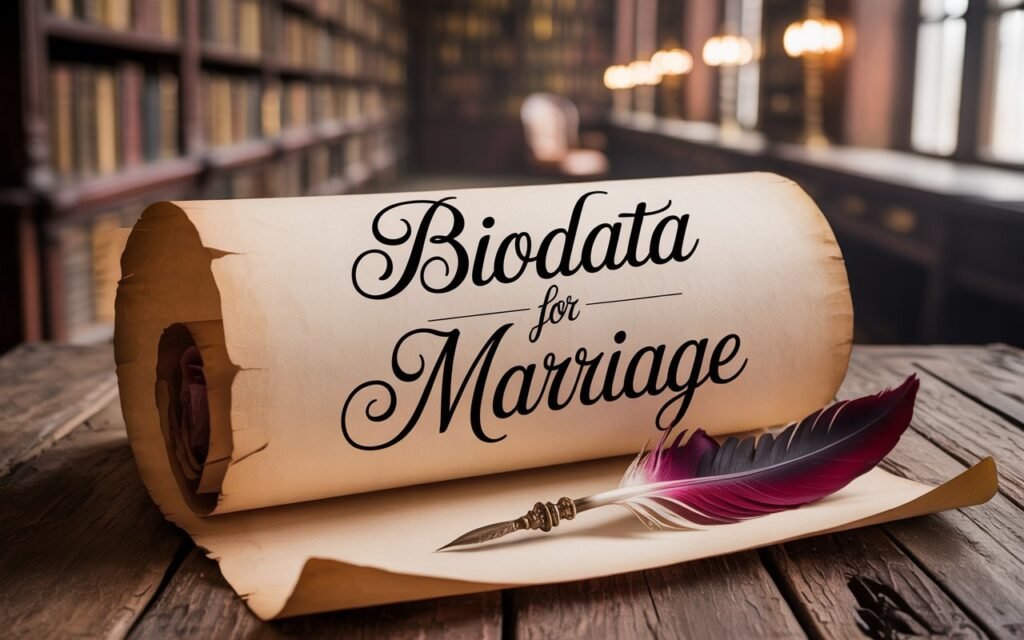In the age of digital matchmaking, a well-designed marriage biodata has become an essential part of the rishta process in India. Whether you’re relying on family introductions, matrimonial websites, or community platforms, your biodata plays a crucial role in creating the first impression. If you’re someone looking to prepare a simple biodata for marriage but don’t know where to start, this guide is for you.
In this article, we’ll cover what a marriage biodata is, what it should include, how to format it, and where to download free templates for quick and easy customization.
What Is a Marriage Biodata?
A marriage biodata is a formal document shared during arranged marriage discussions. It contains personal, professional, and family information about an individual to help potential matches and their families understand their background and suitability. Think of it as a matrimonial resume—concise, factual, and traditionally formatted.
Although formats may vary slightly depending on region, community, or religion, the purpose remains the same: to present one’s profile clearly and respectfully.
Why Go for a Simple Biodata?
Creating a simple biodata for marriage is not about cutting corners—it’s about clarity and focus. Many families prefer concise, easy-to-read formats over elaborate or flashy ones. A clean layout with essential details stands out because it shows professionalism, sincerity, and respect for the process.
Additionally, a simple format is easier to update, print, or share online. This is especially helpful when sending your biodata to multiple families or uploading it on matchmaking platforms.
What Should Be Included?
Here’s a quick checklist of what to include in a basic biodata. Keeping it brief doesn’t mean omitting important information. Rather, you should focus on clarity, accuracy, and tone.
1. Personal Information
-
Full Name
-
Date of Birth and Age
-
Height and Weight
-
Gender
-
Religion and Caste (if applicable)
-
Mother Tongue
-
Contact Information
2. Educational Background
List your academic qualifications starting from the most recent. Include the degree, institution name, and year of passing.
3. Professional Details
-
Job Title
-
Company Name
-
Work Location
-
Annual Income
4. Family Background
This section often holds weight in arranged matches. Mention:
-
Father’s Name and Occupation
-
Mother’s Name and Occupation
-
Siblings and Their Details
-
Family Values (Traditional/Modern/Moderate)
5. Lifestyle & Preferences
-
Dietary habits (vegetarian/non-vegetarian/eggetarian)
-
Hobbies and Interests
-
Languages Spoken
6. Partner Preferences
-
Age range
-
Height
-
Educational qualifications
-
Religion/Caste (if required)
-
Location preference (within India or abroad)
Adding this section helps align expectations and prevents mismatches.
Marriage Biodata Details That Matter
Some applicants make the mistake of either overloading or under-informing their biodata. Remember, marriage biodata details should strike a balance. Avoid excessive self-praise or vague statements. Instead, be specific. For example, don’t just write “engineer”—mention your job title and company. Similarly, instead of saying “good family,” offer brief but real context like “Father is a retired government officer; mother is a homemaker.”
These fine details make your profile credible and easier for others to relate to.
Designing Your Biodata – Tips for Simplicity
-
Stick to a Clean Font: Use basic fonts like Arial or Times New Roman for readability.
-
Use Bullet Points: They make scanning faster.
-
Keep It One Page (Max Two): Ideal for sharing digitally and in print.
-
Add a Passport-Size Photograph: Choose a professional and recent photo.
-
Avoid Fancy Graphics: A bio data for marriage simple in design will always work best.
Should You Go Digital?
Yes! In today’s digital-first world, most families expect a soft copy before any further discussions. That’s why creating your marriage bio data online is convenient. You can:
-
Share it via WhatsApp or email
-
Upload to matrimonial sites like Shaadi.com or Jeevansathi
-
Update details as required without retyping everything
Many free websites and tools now offer ready-to-fill biodata templates for easy customization and sharing.
Where to Get Free Downloads?
If you’re looking for a free download of simple biodata for marriage, here are some top resources:
1. Google Docs & Microsoft Word Templates
Search “marriage biodata template” and you’ll find editable files. These are ideal if you’re comfortable with Word or Google Docs.
2. Canva
This design tool offers elegant and customizable biodata templates. While it includes design elements, you can tone them down to maintain a simple look.
3. Matrimonial Portals
Websites like Bharat Matrimony, SimplyMarry, and Community-based portals offer downloadable formats that suit religious and cultural preferences.
4. Dedicated Blogs
Several Indian wedding blogs provide free PDF or DOCX downloads. These are curated based on regional and linguistic needs, like Punjabi, Tamil, or Bengali biodata styles.
Common Shadi Biodata Mistakes to Avoid
Even the simplest biodata can fall short if not presented thoughtfully. Whether you’re creating a shadi biodata or helping someone in your family prepare one, avoid these pitfalls:
-
Typos or Grammar Errors: They reflect poorly on your seriousness.
-
Outdated Information: Always verify and update your details.
-
Generic Partner Preferences: Be honest and specific without sounding rigid.
-
Overloaded Layouts: Simplicity wins over flashy design in this context.
When to Use a Shadi Biodata Format?
A shadi biodata format is usually more traditional and family-centric. It’s widely used in arranged marriage scenarios where families review multiple proposals and compare basic compatibility. This format works well when:
-
You’re going through community matchmakers
-
Sharing your profile through elders or relatives
-
Targeting a more traditional audience
Even then, the emphasis should remain on clarity and relevance.
Final Thoughts
A well-prepared biodata reflects not just who you are, but how seriously you view the process of finding a life partner. Whether you prefer digital formats or printed copies, keeping it simple ensures your profile is accessible, organized, and respectful of others’ time.
Today, with countless free tools available, anyone can prepare a solid, simple biodata for marriage in just a few minutes. Focus on accurate, honest information, and you’re already halfway to making a meaningful first impression.







